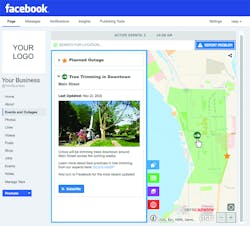Utility Uses Social Media to Connect with Customers
When storms strike, linemen work to restore power day or night. As the crews work out in the field, power companies keep close tabs on the restoration process and dwindling number of outages.
Until now, however, affected customers may not have been able to obtain real-time updates. For example, Braintree Electric Light Department (BELD), an electric and telecommunications municipality serving 35,000 customers, was searching for a way to increase event visibility and awareness to residential and commercial customers. Located only 13 miles from the technology hub of Boston, BELD turned to DataCapable to connect utility data and Esri’s spatial analytics technology on to the municipality’s Facebook page.
Providing Real-Time Updates
As many power companies have learned, social media provides a new mechanism to communicate with customers. As a result, BELD looked for a way to link its data and Esri’s geographic information systems (GIS) capabilities to social media platforms to enhance its relationships with its customers and defer customer calls, benefitting the field workforce.
To keep customers engaged on Facebook and improve event visibility — especially during power outages — BELD needed a way to provide customers with real-time maps with event updates on its Facebook page. The municipality opted to partner with DataCapable, which builds and delivers software-as-a-
service (SaaS) solutions tailored for the utility industry.
DataCapable’s flagship product, UtiliSocial, is a social engagement platform that provides utilities with real-time aggregate outage reports, customer sentiment feedback, weather event data, situational awareness, logistics support and analytics. The platform combs social media channels such as Twitter for specific terms and topics related to the utility. For example, when a customer communicates about certain issues, BELD’s staff members receive real-time notifications so that they can act quickly.
The data is mapped and presented on a dashboard, showing when and where customers engage with the utility. DataCapable’s platform also displays other collected information such as demographics, consumer behavior statistics, natural environment datasets, surrounding utility information and sensor data. Utility communications personnel can view and analyze this information and interact with customers via UtiliSocial.
Improving Response Time
When BELD asked for help in linking map-based visualizations to Facebook, DataCapable developed EventCast, a cloud-hosted module inside UtiliSocial that pairs with Esri’s ArcGIS technology. By allowing clients to integrate with and visualize events on their Facebook pages, the new EventCast solution addresses the most common complaint heard by social operators: customers don’t want to be redirected. Customers want to engage with the utility immediately and directly on the social platforms they prefer.
Leveraging Esri’s ArcGIS platform, event data is presented on the utility’s Facebook page, showing when and where events are occurring. In addition to outage data, EventCast also displays information such as tree trimming, weather, telecommunication construction, existing Esri layers, demographics and consumer behavior statistics, and natural environment datasets and sensors.
Clients now can benefit from faster event presentation, engagement and interaction with customers via the platforms they prefer. For example, more than 50 million businesses use Facebook as a marketing and awareness tool. As such, EventCast provides a new way for power companies to share sensor data, imagery, weather, outages and other GIS datasets.
When customers turn to social media to report something like a power outage, BELD can respond in an informed way and can address the issue faster. Utilities can now visualize outage data, customer communications and imagery from the field in one place and in real time. Weather information helps the utility create predictive models of when outages will likely occur so that staff members can notify customers in areas with a high potential of being affected.
The benefits of this innovation do not end at simply improving response time. With customer data over the long term as a historic baseline, utilities can evaluate present-day events in comparison to previous outages and in combination with asset locations and other Esri visualizations. Staff members can create maps, scenes, apps, layers, analytics and data, and share them with existing enterprise datasets. By analyzing all data — both traditional and nontraditional — utilities like BELD can better understand customers’ key concerns and drive faster outage response.♦
About the Author
Amy Fischbach
Electric Utilities Operations
Amy Fischbach is the Field Editor for T&D World magazine and manages the Electric Utility Operations section. She is the host of the Line Life Podcast, which celebrates the grit, courage and inspirational teamwork of the line trade. She also works on the annual Lineworker Supplement and the Vegetation Management Supplement as well as the Lineman Life and Lineman's Rodeo News enewsletters. Amy also covers events such as the Trees & Utilities conference and the International Lineman's Rodeo. She is the past president of the ASBPE Educational Foundation and ASBPE and earned her bachelor's and master's degrees in journalism from Kansas State University. She can be reached at [email protected].

